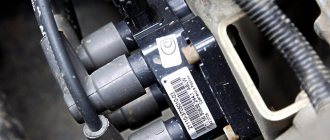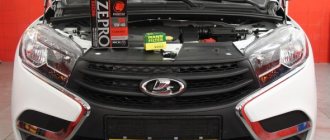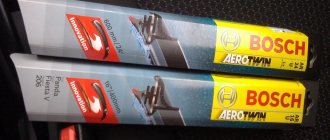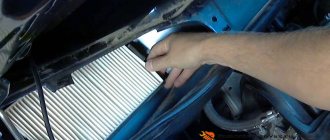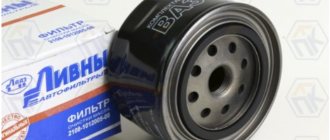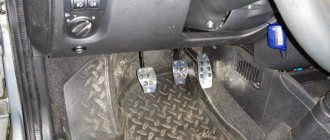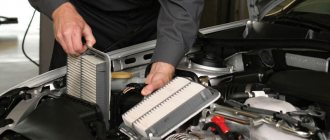On most modern cars you can see plastic elements inside the wheel arches. These are nothing more than fender liners or lockers. These elements perform a fairly important function. Lockers are designed to protect the bottom and underwheel space of the car from dirt, water, dust, and reagents that fly out from under the wheels. And if water, dirt and dust cannot cause significant damage to the body, then the reagents are quite dangerous. Installing wheel arch liners is an important part of car care. Let's see what lockers exist and how to install them correctly.
Types of fender liner
In the modern car spare parts market, various types of wheel arch liners are widely represented. They differ in materials. Plastic, polyethylene, and fiberglass accessories are especially popular. Previously, there were also metal fender liners - they were made mainly of aluminum and galvanized sheet steel. But today metal fender liners are not relevant and are practically not used.
Also, in addition to solid fender liners, there are also liquid ones. These are special formulations in aerosol cans. They are applied to the space under the wing and are designed to protect the metal from moisture, dirt, and reagents. But over time, the protective coating wears off and you have to reapply the layer.
What if the car has been in use for more than 6 years?
Expert advice on replacing the clutch cable on a Lada Granta
Here, guys, it is better to install fender liners, the point here is this - the composition of polyvinyl chloride, bitumen or wax, wears out over time, sometimes even falls off. Therefore, the metal is left alone with the harmful environment. Again, sand and salt on the roads act as an abrasive compound that wears off not only the protective compound, but also paint and even primer from the bottom. Therefore, metal left without protection very quickly rusts and then rots. So they will come in handy here, as they will not allow sand and salt to wear off this composition and will save you from any external influence.
And in general, after six to seven years of operation of the car, it is necessary to carry out preventative maintenance on the body, it is advisable to once again apply a protective composition to the bottom and under the wings of the car. Install protective fender liners, treat hard-to-reach cavities, etc. This way, you will extend the life of the car body by several more years.
Plastic and fiberglass
ABC plastic is used to make these parts. It has all the advantages of polyethylene, but is more rigid. Such products are found in stores very often. These wheel arch liners are also easy to repair. If a plastic product is wrapped under a wheel, it will simply become deformed or break. The metal part in this case may damage the wheel.
Fiberglass is even more rigid and therefore products made from it are not very popular among car owners. But if necessary, fiberglass fender liners are also easy and good to restore and will not harm the car in a critical situation.
Armored film
This innovation appeared relatively recently, but has already gained considerable popularity. Abroad, the use of armored film, which perfectly protects especially vulnerable areas of a car, is practiced on the assembly line, preserving sills, aprons, bumpers, glass lamps and headlights, and other important parts of the body and interior. Such films come in different thicknesses and also give an amazing positive effect. Many drivers are attracted by the fact that they are invisible from the outside and do not spoil the design or aesthetic impression of the car. A certain disadvantage is sometimes called the fact that it is very difficult to install such a film on your own - this can only be done by experienced specialists in a specialized place.
How to choose?
Installing fender liners should protect the car. Therefore, you should first choose and buy these parts wisely.
Usually the product indicates the make of the car for which the part is intended. The marking also encrypts the installation side - rear or front. Sometimes the manufacturer's brand is indicated, and even less often it is possible to determine the material from which the part is made from the markings.
When choosing a kit for installing fender liners on a Renault, you should pay attention not only to the cost, as most car enthusiasts often do. The material and shape of the part are very important. Manufacturers can produce different parts for one car. Some fender liners have mud flaps that form a single piece with the fender liner. They can significantly reduce the contamination of the wing on the side, on the door side. In addition, these products are more rigid.
Next important is strength. To install the fender liners, you will need a kit where the material is not too soft, but not too hard. If the part is soft or partially deformed, then this indicates that the economical manufacturer used recycled material as the starting material. The material undergoes rapid aging; on a frosty day, such a fender liner can easily break into pieces by hand. On a hot summer day, the part may sag.
Polyethylene products can withstand frost and high temperatures perfectly. But here, too, not everything is so simple - you need to protect the elements from ultraviolet radiation. It has a destructive effect on plastic. Therefore, you should not purchase a kit that has been lying in the sun.
If you want silence
For those car enthusiasts who want to reduce driving noise, these protective materials are perfect. Such products combine excellent anti-corrosion properties and sound insulation functions. For example, those who have used liquid fender liners have simply rave reviews about the degree of sound insulation. So, you can practically not hear the stones from the road, which previously flew off and thuddedly hit the fender liner. Some motorists used various bitumen-based mastics instead of factory products. And if they reliably protect against corrosion, then to reduce noise it is better to use what the industry leaders offer. Modern liquids are sold in cylinders. They are easy to apply, dry quickly and provide an excellent level of protection. With them you can not be afraid of road reagents in winter and country roads in summer. With such fender liners, the car will not be overcome by corrosion, and its owner will be calm and satisfied. So, we found out what reviews and characteristics of automotive liquid fender liners are. Have a nice trip! No nail, no rod!
Preparation for installation
Before installing the fender liners, the car should be raised and the wheels should be removed. Next, thoroughly clean the wheel arches with a brush and dry them with a compressor.
It is better to try on the protective element first. A high-quality product must be very accurately installed in the arch niche. If there are minor discrepancies, they can be easily removed by heating with a hair dryer. If the product is installed correctly and made with high quality, then it will not rub against the tire anywhere and in any position.
Continuous elements are usually secured using self-tapping screws. Fastening is carried out to the edge of the niche, and is also fastened in the niche itself. If the fender liner is split, then it is also fixed in its lower part. If you use self-tapping screws rather than latches for fastening, then for safety and security when installing fender liners on a Lada, it is better to screw in a few additional screws.
Mastic Мercasol Sound Deadening
It contains rubber and various polymers, which makes it effective protection against gravel and other road debris. In addition, it also acts as a sealant.
Before applying the composition, the surface to be treated should be cleaned of dirt and degreased.
. For application, a spray gun is used, which includes an adjustable nozzle. Mastic is also applied under pressure using special equipment. The thickness of the applied layer is from 0.5 to 0.7 mm.
This mastic has its disadvantages:
- It is applied only to those surfaces that have not previously been treated with other substances.
This can only be done by professionals in specialized centers.
Installation
Most solid products are mounted in the same way according to the scheme described above. About 7 screws are used. They attach the fender liner to the edges of the car's wing. About 3 self-tapping screws are needed for installation in the depth of the arch. Sometimes, in the case of split fender liners, the lower part is also attached.
If the wheel arches are already susceptible to rust, then it is better to pre-treat them generously with suitable anti-corrosion compounds. This will protect the metal from the development of corrosion. It is also better to treat holes drilled for self-tapping screws, and some experts recommend applying sealant to them. Also, when installing the front fender liners, as well as the rear ones, it is worth using galvanized self-tapping screws - they are more resistant to corrosion processes.
Methods
For most drivers, mud flaps are rubber flaps that are installed behind the wheels near the bottom of the front fender and rear bumper. If we are talking about a car body, then a mudguard is usually called a metal casing that connects the spar, the engine shield and the wings in the nose (the shock-absorbing strut cup is part of the mudguard). In the rear part there is a mudguard - the wheel well of the body. The protection of these body elements will be discussed.
The car owner has only 2 ways to protect wheel arches:
- installation of fender liners. The plastic casing is attached to the wings and the internal cavity of the mudguards;
- liquid protection. The arch is treated with a special anti-gravel material based on bitumen and anti-corrosion components. For application, use a special gun that sprays a liquid mass, or a brush. After drying, a dense, damping surface is formed on the body, which has noise and vibration insulation properties.
Sound insulation deserves special attention. Due to vibrations from driving over uneven surfaces and the rolling noise of tires, the cavities of the mudguards are quite vibration- and noise-laden areas. Water, dirt and large stones flying from under the wheels, hitting the metal part of the body, resonate, which leads to the transfer of noise into the car interior. Good noise insulation protection of the wheel arches significantly increases the level of comfort.
Which is better
If we consider plastic fender liners and liquid protection separately, it is difficult to choose the best method. If there are factory places for attaching protection, as well as corresponding plastic products, it is better to give preference to fender liners. They are more durable in use. To install rubber mud flaps, you will not need to drill into the body, which is a huge advantage.
If there are no standard places for fastening in the wings, and the owner does not want to bother installing lockers without screws, then it is better to choose liquid sound insulation. In terms of the level of transmitted noise, these methods of protection are approximately the same, but the disadvantage of liquid fender liners is their fragility. Constant impacts of stones, dirt, moisture, temperature changes and vibrations of the body lead to delamination of the material. As practice shows, even high-quality processing must be repeated every 2-3 years.
Selection of lockers, mastic, sound insulation
Guidelines when choosing fender liners:
- thickness. Products that are too thin are damaged faster and are more susceptible to deformation in the hot season;
- elasticity. Lockers are made of ABS or PP plastic. The latter option is more elastic and therefore often more durable. But even with the same labeling, you can feel the difference between manufacturers. You should not buy products that are too hard, as the material will become completely hard in the cold, which can cause cracking;
- presence of stiffeners;
- holes for standard fasteners, if provided.
The choice of manufacturers is huge (API, ASAM, SA, FLORIMEX, GORDON, KLOKKERHOLM, POLCAR, SAT and many others). You need to identify manufacturers offering fender liners for your car model, and then ask about the operating experience of other car owners. One of the main factors, which, unfortunately, can only be checked during installation, is the coincidence of the body moldings with the shape of the fender liner. This will allow protection without distortion and tightly close all cavities.
Mastic, soundproofing materials
Previously, we have already considered the application of liquid sound insulation, on top of which lockers can be installed. To form liquid fender liners, you can use Dinitrol 479. As a pre-treatment before installing the lockers, you can use anti-corrosion mastic with a noise-absorbing effect from APP, Terotex, Schwarz or other manufacturers.
The following are used as sheet insulation:
- base layer of vibration-absorbing composition with a thickness of 2 mm;
- soundproofing material.
There are now a huge variety of material models, as well as manufacturers (Shumoff, STP, Vikar, etc.). Therefore, when choosing, you should focus on the price, as well as the thickness of the final coating. The noise-insulating “sandwich” should not interfere with the installation of lockers. It is advisable to buy material with an adhesive layer based on mastic rather than water-soluble adhesives.
Peculiarities
Sometimes the installation may have some peculiarities due to the material and design of the fender liners. Thus, plastic and fiberglass products have high rigidity. Because of this, they cannot be screwed tightly over the entire area of the part. This can lead to destruction - the fender liner can easily burst from vibrations. Therefore, when installing the rear and front wheel arch liners, these parts are secured using brackets and latches. This installation method is significantly safer for the body - no additional holes need to be drilled. This solution is very often used by foreign automakers when assembling cars at the factory.
The fender liner, installed correctly, should be slightly free. The geometry of the elements themselves is also important. Many products have bosses, which make it possible to perform installation accurately and without distortions. This allows you to simplify the task for those who decide to independently install fender liners on a VAZ. If the part is not properly secured in the arch, some parts of the body may not be protected.
Correct installation of lockers
Many cars have factory mounting locations for fender liners. Special plastic “bugs” are used as fastening elements. The use of self-tapping screws is permissible when attaching lockers to plastic elements (decorative threshold trim, bumpers). If processed correctly, self-tapping screws can be used as fasteners at the bottom of the internal cavity of the mudguard.
Never use self-tapping screws to attach the fender liner to the edge of the wing. Moisture is trapped between the plastic casing and the wing. In the place where the metal is exposed, rusting will inevitably begin, which, moving upward, will destroy the paintwork.
When you can't do without self-tapping screws
If another installation method is not possible or if holes have already been drilled in the wing before you, the metal must be protected. If there are no traces of rye in the area where the paintwork is damaged, prime the area with epoxy primer and paint it with acrylic paint from a spray can. Rusted areas must first be cleaned and treated with a rust converter. After drying, treat the inner cavity of the wing and the edge adjacent to the fender liner with anti-corrosion mastic (for example, Movilya). Also soak the self-tapping screw in mastic before screwing it in.
Useful solutions
Often, protecting wheel arches with fender liners can only do harm. Vibrations from a poorly secured product damage the paintwork in the plane of contact with the wing. There are two ways to deal with this:
- The edge of the locker is trimmed, and a special seal is put on it. The soft rubber coating fits tightly to the wing and does not scratch the paint;
- use of body sealant. It is applied where the plastic adheres to the body. Promotes waterproofing, which is important for both paintwork and laminated sound insulation. The sealant not only performs a waterproofing function, but also acts as an additional fastener. After drying, it remains elastic and therefore does not crack.
High-quality preparation of a car for operation involves the use of fender liners - special plastic devices to protect the body space around the wheels. Today, various manufacturers offer car fender liners that are ideal for your model, specially designed to take into account all the shapes and features of the wheel arches. It should be noted that this particular protection option is the most important and necessary to preserve the body from corrosion. The paint under the wheels is quickly scratched off due to constant attack by small stones, sand and water, so rust in these places forms within a matter of weeks of using the car. It is necessary to install fender liners immediately after purchasing the car and protect the body from further destruction. If rust has already begun to spread, it is better to treat these areas.
Causes of corrosion damage
Drivers should understand that externally treating doors with anti-corrosion agents will be useless if rust destroys the metal from the inside. The cavity, which is located under the casing, serves as a pocket for the side glass, laid cables, sensor units, etc. must be protected from corrosion as thoroughly as the visible part of the door. Causes of corrosion:
- poor anti-corrosion treatment of metal;
- electrochemical process;
- systematic contact with water;
- anti-ice reagents.
Anti-corrosion treatment involves not just coating the doors with bitumen mastic or liquid paraffin, but also inspecting the metal first. If there are already traces of rust on the door, then the use of a preservative that stops the spread of corrosion will not be sufficient. It is necessary to clean the damaged area, prime it, and protect it with anticorrosive.
Electrochemical corrosion occurs at welding sites because the integrity of the metal is damaged at the points of contact between the aluminum patches and the steel.
If the drainage holes in the threshold are clogged, then there is always moisture inside the door, which contributes to the oxidation of the metal and rapid rotting. At the same time as the door, the thresholds begin to collapse, water gets into the cracks between the lining seals, penetrates into the inner frame, and destroys the body from the inside.
In winter, city streets are sprinkled with a salt composition so that the ice does not freeze in blocks and makes it easier to remove. Salts and aggressive chemicals, getting on the paintwork of the body and remaining in the cracks, destroy parts much faster than water. This is facilitated by the presence of scratches, chips, dents with damage to the paintwork.
How to choose plastic trims according to the size and model of your car
First of all, it is necessary to determine for what purpose the expanders are needed. If it is necessary to protect the wheel arches from corrosion in a car with conventional standard wheels, then you are limited to installing universal plastic spare parts. When it is planned to install wide non-standard wheels, the fenders should extend beyond the dimensions of the body, but no more than 50 mm.
When choosing plastic trims, you must carefully ensure that the geometric dimensions of the arches coincide with the parameters of the installed fenders and that there is complete alignment from one end to the other. Otherwise, in places where gaps are left, the metal will begin to corrode.
According to traffic regulations, it is allowed to install black overlays. If the extensions are mounted to match the body, then spare parts for painting are used.
The original elements contain branded labels, with the help of which you can find the characteristics of certain products on the Internet.
Processing rules
When treating wheel arches with anti-corrosion agents, certain rules are followed that allow you to achieve the desired effect:
- Rinse the surface thoroughly. If you miss this moment, all further work will be useless, since the protective compounds will not adhere to the metal.
- Dry and degrease surfaces. If traces of fat or moisture remain, the effect will not be sufficient.
- Clean the metal from rust. Since the compounds used serve to protect and not to remove rust, in order to treat the wheel arches of a car, it is necessary to clean the metal from traces of corrosion.
- The arches must be carefully coated. You should not skimp on protective drugs. Read the instructions for what area of treatment the product is designed for.
If you follow the above rules, the efficiency of processing arches increases significantly.
Plastic protection
Such lockers have been used for quite a long time. It is better to install plastic protection on new cars that have not yet been exposed to much contamination. They are suitable for both Russian cars and foreign cars. Special polyethylene is used for their production. This material is quite elastic, its wear resistance is at a high level, and it is precisely these qualities that are important on Russian roads.
The plastic used in the production of lockers does not change its characteristics even at extreme temperatures. This type of protection has its undeniable advantages:
- Decent protection against de-icing agents.
- Protection against corrosive processes.
- The initial form remains for quite a long time.
- Strength.
- Consistency of characteristics at high and low temperatures (from -50 to +50).
But there are some drawbacks here, the main one of which is considered to be the method of fastening plastic using self-tapping screws
. This may well lead to corrosion in the areas where the holes form. But experts believe that this statement is relevant only in the case of unprofessional installation of protection. When drilling holes, professionals use anti-corrosion and special galvanized screws, so the risk of rust is reduced to zero.
In addition, if you choose lockers designed for use on a specific car, then you won’t have to drill anything. Manufacturers combine all technological holes with mounting points under the wheel arch of the vehicle for which these lockers were intended. Each car uses its own fender liner model.



